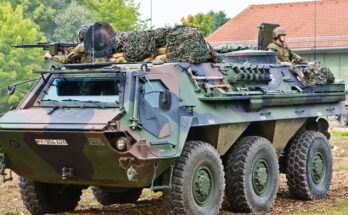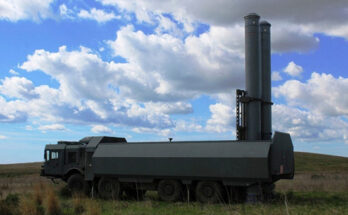On November 12, against the backdrop of French President Emmanuel Macron’s declaration in a recent The Economist interview that the NATO Alliance is currently experiencing “brain death,” the European Union (EU) announced its latest batch of joint projects under its embryonic defense cooperation initiative.
Europe stands on "the edge of a precipice" and must start thinking of itself more strategically to remain "in control of our destiny", France's president says https://t.co/iuSha3lJJ5
— The Economist (@TheEconomist) November 7, 2019
The EU Council gave approval to a third batch of projects conducted through its Permanent Structured Cooperation (PESCO) initiative, which comprises 25 of the 28 EU member states. The latest batch of 13 projects brings the total number overseen through PESCO up to 47. The first two batches were adopted in the spring and fall of 2018.
According to the EU head of foreign and defense policy, Federica Mogherini, there will be no more PESCO projects initiated through 2020, in order for the focus to turn to implementation. For now, the idea is to step back and take a midpoint assessment of the projects before moving forward with a fourth batch.
All of which makes sense and provides the initiative with a kind of trial run period, but the next evolutionary step – besides delivering on the capabilities requirements through PESCO projects – will be to progress towards larger capital projects and high-end capabilities. But for now, still in the earliest stage of inception, PESCO remains a useful channel for intensifying European defense cohesion.
What exactly is PESCO?
PESCO is an attempt within the EU to develop means for standardization of training, development, and information flows that will allow European forces to cooperate and execute smoothly in operational settings. All of this is to be done through synchronization of capabilities requirements and goals and harmonization of investment in research and technology and procurement. The ideal result is greater Europeanization of capabilities and supply chain cultivation – and thus greater European strategic autonomy.
Following a series of events starting in 2014, this ambition grew in focus. These events included Russia’s destabilizing behavior along Europe’s eastern frontier and utilization of hybrid warfare tactics in Ukraine, the Brexit referendum in the U.K., and concern over U.S. strategic reorientation towards the Pacific Rim and deteriorating relations under President Donald Trump.
The latter, in particular, has brought Europe’s enduring dependence upon an American security umbrella under the microscope. This was the gist of Macron’s comments in The Economist interview, which followed Trump’s decision to withdraw U.S. military forces from the northeastern Syrian border with Turkey without first consulting Washington’s European allies.
Each of the aforementioned factors underpinned newfound resolve in European leaders looking for ways to build greater military integration capable of serving as a binary defense component to NATO and acting in accordance with EU foreign policy aims and military operations under its Common Security and Defense Policy (CSDP).
Multiple mechanisms were launched throughout 2017 to achieve this end. In June 2017, the European Defense Industrial Development Program (EDIDP) and the European Defense Fund (EDF) were launched, and in November of that year, PESCO and the Coordinated Annual Review on Defense followed, the latter on a trial basis.
The basic formula involves three elements – CARD, EDF, and PESCO – used in conjunction. These mechanisms build off the EU’s Capability Development Plan (CDP) in a down-funnel process flowing in this manner:
- European governments identifying medium- and long-term capability priorities.
- Through CARD, a complete picture of the capability landscape is formulated with cooperation opportunities identified.
- Funding for joint capability projects is drawn from EDF, which in turn supports the broader EU defense industrial landscape.
- Programs are carried out via PESCO.
- Final capabilities are owned by each participating EU member state.
CARD, however, is only now moving from trial basis towards full implementation under the “secretarial” oversight of the European Defense Agency (EDA). Meanwhile, the European Defense Fund has a bucket of just €500 million ($551 million) to co-finance projects during the 2019-2020 period.
Thus, for now, the PESCO projects remain small and tangible in scale and scope. The aim is to tackle capabilities goals across all domains and meet EU Level of Ambition (LoA) shortfalls, with – in the near term – particular emphasis on the front end in the areas of cybersecurity and joint training.
Under the latest batch of 13 projects, two stand out.
The first involves the Maritime Unmanned Anti-Submarine System (MUSAS), which aims to develop an advanced command, control, and communications (C3) architecture for anti-submarine warfare involving new-generation technology and artificial intelligence (AI).
The second project concerns the design and development of a prototype for a new naval vessel called the “European Patrol Corvette” (EPC). This project will involve France and Italy, two countries who have previously worked together to achieve commonality of design and scale through joint procurement of naval warships.
Notably, France – which has long spearheaded the idea of a European defense pillar – has signed on to 30 of the 47 total PESCO projects and 10 of the recent batch of 13. Germany, meanwhile, is a co-signer to just 16 of the 47 total projects and only 2 of the latest 13.
In short, France is putting words to action where its larger goal of greater European defense cooperation is concerned. Yet its most crucial partner in the project still lags. And while France clearly desires the rest of Europe to wake up from its strategic lethargy and learn to row together (ostensibly under French influence and leadership), the road to European strategic autonomy remains a distant – if ever-elusive – dream.

European Union flag – Flickr/Yanni Koutsomitis
Dan Darling is Forecast International’s director of military and defense markets. In this role, Dan oversees a team of analysts tasked with covering everything from budgeting to weapons systems to defense electronics and military aerospace. Additionally, for over 17 years Dan has, at various times, authored the International Military Markets reports for Europe, Eurasia, the Middle East and the Asia-Pacific region.
Dan's work has been cited in Defense News, Real Clear Defense, Asian Military Review, Al Jazeera, and Financial Express, among others, and he has also contributed commentary to The Diplomat, The National Interest and World Politics Review. He has been quoted in Arabian Business, the Financial Times, Flight International, The New York Times, Bloomberg and National Defense Magazine.
In addition, Dan has made guest appearances on the online radio show Midrats and on The Media Line, as well as The Red Line Podcast, plus media appearances on France 24 and World Is One News (WION).




